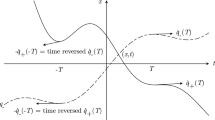Abstract
It was shown by de Broglie and Bohm that the concept of a deterministic particle trajectory is compatible with quantum mechanics. It is demonstrated by explicit construction that there exists another more general deterministic trajectory interpretation. The method exploits an internal angular degree of freedom that is implicit in the Schrödinger equation, in addition to the particle position. The de Broglie-Bohm model is recovered when the new theory is averaged over the internal freedom. The model exhibits a strong form of entanglement which implies a primary role for the wavefunction of the Universe. The conditions of autonomy are examined, and the viability of the theory is established by application to the measurement problem.
Similar content being viewed by others
REFERENCES
L. de Broglie, J. Phys. 8, 225 (1927).
D. Bohm, Phys. Rev. 85, 166, 180 (1952).
P. R. Holland, The Quantum Theory of Motion (Cambridge University Press, Cambridge, 1993), Sec. 3.2.
If we extend the question beyond deterministic theories, the answer is surely yes-it is well known that there exist stochastic models describing motion that deviates from (1.1) but which reproduces quantum statistics (and (1.1) ) on the average. See, e.g., E. Nelson, Quantum Fluctuations (Princeton University Press, Princeton, 1985).
D. Dürr, S. Goldstein, and N. Zanghi, J. Stat. Phys. 67, 843 (1992). E. Squires, in Bohmian Mechanics and Quantum Theory: An Appraisal, J. T. Cushing et al. eds. (Kluwer, Dordrecht, 1996) 131. R. J. Sutherland, Found. Phys. 27, 845 (1997).
E. Deotto and G. C. Ghirardi, Bohmian mechanics revisited, quant-ph/9704021.
See, e.g., S. T. Epstein, Phys. Rev. 89, 319 (1952); 91, 965 (1953). D. Bohm, Phys. Rev. 89, 319 (1952). H. Freistadt, Suppl. Nuovo Cimento 5, 1 (1957). G. GarcõÂ a de Polavieja, Phys. Lett. A 200, 303 (1996).
We emphasize that we are simply rewriting the usual complex Hilbert space formalism in terms of real functions. This is not the same as so-called “real” quantum mechanics which uses only the first term on the right-hand side of the scalar product (2.6) and has different physical content. See S. L. Adler, Quaternionic Quantum Mechanics and Quantum Fields (Oxford University Press, Oxford, 1995), p. 44.
V. Heine, Group Theory in Quantum Mechanics (Pergamon Press, London, 1960), Chap. 7.
In what follows the definition of the Euler angles and the relevant results from the quantum theory of rotators are drawn from Ref. 3, Chap. 10, and references therein.
Ref. 3, Sec. 3.9.
Ref. 3, Chap. 8.
P. R. Holland, in Bohmian Mechanics and Quantum Theory: An Appraisal, J. T. Cushing et al., eds. (Kluwer, Dordrecht, 1996), p. 99.
For details, see J. T. Cushing, Quantum Mechanics: Historical Contingency and the Copenhagen Hegemony (University of Chicago Press, Chicago, 1994), Chap. 8.
A. Einstein, Dialectica 2, 120 (1948).
Rights and permissions
About this article
Cite this article
Holland, P.R. New Trajectory Interpretation of Quantum Mechanics. Foundations of Physics 28, 881–911 (1998). https://doi.org/10.1023/A:1018813112648
Issue Date:
DOI: https://doi.org/10.1023/A:1018813112648



